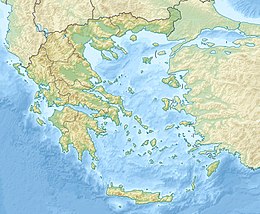| UTC time | 1995-06-15 00:15:48 |
|---|---|
| ISC event | 98709 |
| USGS-ANSS | ComCat |
| Local date | 15 June 1995 |
| Local time | 03:15:48 EET |
| Magnitude | 6.4–6.5 Mw[1][2] |
| Depth | 3–14.2 km (1.9–8.8 mi)[2][3][4] |
| Epicentre | 38°24′04″N 22°16′59″E / 38.401°N 22.283°E |
| Type | Normal faulting[4] |
| Areas affected | Greece |
| Total damage | US$660 million[5] |
| Max. intensity | MMI VIII (Severe)[1][6] EMS-98 IX (Destructive)[7] |
| Peak acceleration | 0.54 g[8] |
| Foreshocks | Many, largest was Mw4.6[9] |
| Aftershocks | Thousands, largest was Mw5.6[1][4] |
| Casualties | 26 dead, 60–200 injured[8][10] |
An earthquake struck Western Greece near the coastal city of Aigio at 03:15:48 local time on 15 June 1995. The second destructive earthquake to strike Greece in a month, it measured 6.4–6.5 on the moment magnitude scale (Mw ). It was assigned a maximum Modified Mercalli intensity of VIII (Severe) and EMS-98 intensity of IX (Destructive). The horizontal peak ground acceleration reached 0.54 g and ground velocity peaked at 52 cm/s (20 in/s)—the strongest ground motion ever recorded in Greece. Fifteen minutes after the mainshock, a large aftershock struck, causing further damage to Aigio. Faulting occurred on either the Aigion fault or an unnamed offshore fault. Other faults in the region have the potential to produce earthquakes up to Mw 6.9, which poses a risk to Aigio and the surrounding Gulf of Corinth.
Monetary damages from the earthquake reached $660 million (in 1995 USD). Significant destruction occurred; the collapse of two buildings left 26 dead and up to 200 injured. In the aftermath, several countries and organizations provided disaster aid, including search and rescue and refugee assistance operations. Many countries also donated medical supplies, temporary shelter, water treatment equipment, and a ship to house survivors. The Greek government issued seismic loans to aid in the rebuilding of Aigio, though it may have encouraged the construction of taller buildings—increasing Aigio's future seismic hazard. Controversy arose over the lack of a warning for the earthquake, as several sources warned officials that a major earthquake would occur.
- ^ a b c Lekidis et al. 1999.
- ^ a b Cite error: The named reference
USGSwas invoked but never defined (see the help page). - ^ Del Gaudio, Pierri & Chousianitis 2019.
- ^ a b c Bernard et al. 1997.
- ^ Cite error: The named reference
NGDCwas invoked but never defined (see the help page). - ^ Papazachos & Papaioannou 1997.
- ^ Pomonis, Gaspari & Karababa 2014.
- ^ a b Koukouvelas 1998.
- ^ Ravnalis et al. 2022.
- ^ Schwarz, Schwarz & Oikonomou 2017.


